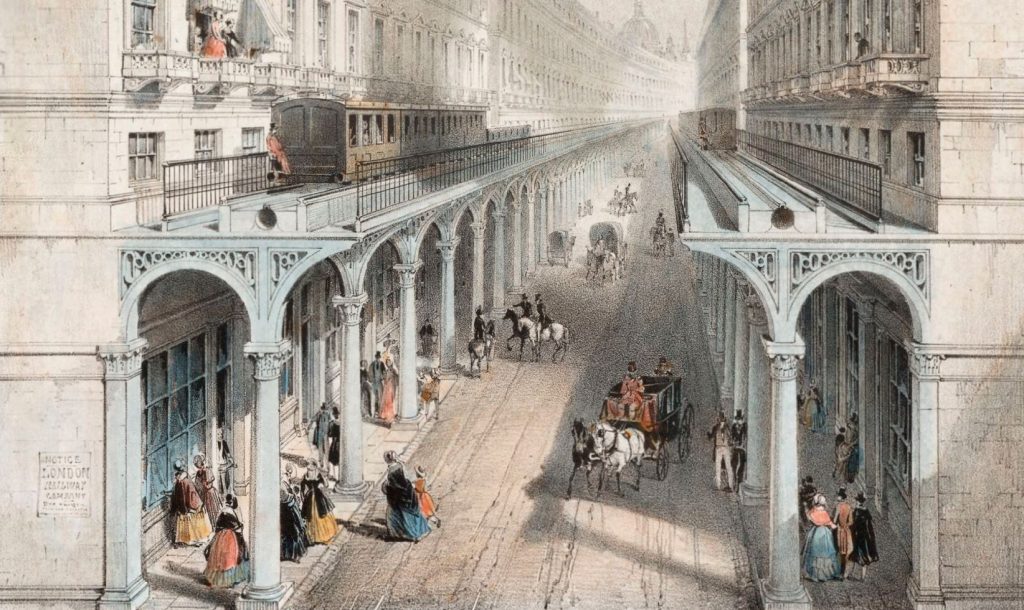Imagine if you will of streets lined with decorative arcades that protected Victorians from the weather and above their heads, a marvel of the age – a silent railway without steam.
This was 1846, and Mr James Clephan had founded the London Railway company with capital of £5 million to build a loop railway around the centre of London mimicking the route that is today served by the Circle Line.
However, it would also have run through the heart of the city, and while railways had enormous powers to demolish houses in urban areas that got in the way of their iron machines — the City was a far stronger foe to do battle with.
So the clever Mr Clephan had a plan. To cover the pavements with an arcade, so that shoppers on foot would be able to walk protected from the wind and rain, and above their heads, would run the silent trains.
No need to demolish the shops and offices. His ace was that he planned to make use of Brunel’s Atmospheric Railway technology. This propelled carriages along by pneumatic air pressure in a pipe running under the carriages. In theory, at least this did away with the noisy smelly steam engines that were usually needed. To run steam trains through the heart of the city would have aroused considerable opposition, so the plan to use the silent atmospheric trains would have overcome the objections.
His plan looked good, but upon closer study, it was deeply flawed.
For a start, the atmospheric railway was a doomed project, and experiments with it were a failure. The leather flaps that were needed to keep the pressurised air inside the tubes were prone to break, and were far less silent in operation than had been hoped. All the attempts to use them were swiftly replaced with normal steam trains.
A Commission was also underway to look into options for a major railway terminus in the centre of London — and Mr Clephan proposed the radical idea of a circle-line linking the existing railways rather than building the proposed terminus.
His railway would have run from Waterloo, over the bridge — which would have had an arcade built upon it, up towards Euston station, King’s Cross, down towards Liverpool Street, over the (at the time little used) Southwark Bridge, Blackfriars and back to Waterloo.
A branch line would have extended out towards London Bridge.
It’s the bit running through the city that would have seen the streets lined with the colonnades to create the arcades. However, as an investigation into the plans pointed out, the frontages of every single building along the route would need to be rebuilt.
Wouldn’t it be better to buy up the properties instead they asked? Of the £5 million capital proposed, £3.3 million was already earmarked for buying homes along other parts of the route.
The Commissioners were unconvinced by the amount proposed, noting that a short length of the railway at Fenchurch Street of just 500 yards cost around £250,000 to buy the land.
Unsurprisingly, the Commission determined that Mr Clephan had set up a company with no money and no deposits at the time of the submission.
“As its projectors contemplate occupying two of the bridges of the Thames, and passing through the heart of the metropolis in two directions in a most objectionable way, we consider this scheme altogether inadmissible” they concluded.
In doing so killing off a novel experiment in running an atmospheric railway through the centre of London.
But what a remarkable legacy it could have left – the railway would be long gone now, but the long lines of arcades would probably still remain, and would be one of the defining features of central London’s streets.
Sources:
The Railway register and record of public enterprise for railways. Volume 4
The Railway Times, 4th July 1846









Fascinating! Not seen this one before. Presumably it predates the similar scheme by Paxton?
Couldn’t such a scheme have eventually been utilized later by some form of DLR?
I’m not sure why the story says the railways would be long gone now? Assuming they could have got it to work, why assume that?
Because they never did manage to get it to work – even today the principle of the atmospheric railway still doesn’t work.
They built it in Chicago and called it “the El” 😉
Also there’s a splendid pet project by a wealthy californian vineyard owner which appears to have beaten the pressure loss from the Brunel leather flaps.
The vacuum pipe is just that, a contiguous pipe with no slit for a connection to the train. Instead it uses magnets on the train and magnets on the propelling vessels inside the tube.
One for the future and arguably simpler than others more heavily covered in the recent press.
This idea of a first floor tram level could be used to break the deadlock between factions
(Mayor): “pedestrianise Oxford Street”,and Westminster City Council :”leave in some public transport”.
Put a first floor level two-way, high frequency, three carriage tram along the whole of Oxford Street(and Regent Street if you have the money). Meanwhile make the whole of Oxford street (and Regent Street) completely pedestrianised. A flower here and a tree there would not come amiss.
Obviously, everything turns on the design of the tram system which should be in middle of roads not along edges. Escalator service to tram level. Frequent (2 and 1/2 minutes max). Low standard fare for any journey.Turn around (or reverse)at Marble Arch/Tottenham Court Road, (and Piccadilly Circus/Regents Park).
We can have both pedestrianization AND a rapid transit to the shops in question along the whole of BOTH Oxford Street and Regent Street. With Crossrail delivery of passengers and rapid transit an order of magnitude(10x) increase in footfall ON A DAILY BASIS.